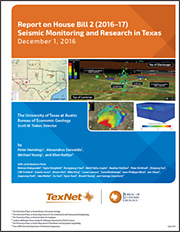Synopsis: Determine drivers governing stakeholder beliefs, information seeking mechanisms, and response regarding seismic risk and develop improved communication strategies
Project Status: Active
Funding Source: 100% CISR IA
Research Leaders: Mary Beth Deline, LeeAnn Kahlor, Art Markman, Hillary Olson
Project Start: 1Q2016
Project Interface: Project interfaces closely with Texas Seismicity Studies, Ft. Worth Basin Earthquake Characterization, and the Seismic Hazard and Risk Assessment projects
Expected research outcomes:
- Data on public perception of earthquakes in regions that are prone and not prone to earthquakes and associated risk
- Input to communication strategy development
- Recommendations as to the responsiveness of regulators and other professional stakeholders
- Development of a pilot teaching module for effective communication about seismicity
Potentially induced earthquakes are occurring in areas of limited natural historical seismicity. Consequently, stakeholders, including local residents and media, are frequently unfamiliar with the reasons for seismicity as well as the potential risks associated with it. Informing these stakeholders will require the delivery of research results that speak to causes and risks associated with seismicity. However, these results will not resonate with stakeholders unless they are communicated in a way that recognizes and responds to the values, beliefs, and emotions that the groups bring to the issue.
This research thrust aims to understand stakeholder beliefs and values to better assess and predict emotional reactions to information on seismic risk, to identify key sources of resistance to scientific data about induced seismicity, and to develop a set of principles to predict stakeholder response to scientific information on natural and induced seismicity. Part 1 of this research project will gather survey data from 1,200 randomly selected Texans. Data collection is from June 2016 through September 2016. Sampling frame consists of mailing addresses and phone records purchased from SSI. We are oversampling to achieve a final sample of 1,200. Participants will come from 5 communities for variance in seismicity experience/history. The purpose of this portion of the program is to better understand how Texans think and gather information about seismicity in Texas. This data is needed to locate the best approach for delivering responsive and audience-centered information about seismicity.
Part 2 of our research project focuses on meeting with the oil and gas regulatory community to hear their input on the depth and breadth of information on seismicity needed to fill the current information needs of the public and information needs within the regulatory community. Data will be collected through focus groups. Transcripts of the focus groups will be transcribed and analyzed via content analysis to locate themes across the participants’ discussions. These focus groups will be held in October 2016 and February 2017.
Finally, we will leverage the findings from Parts 1 and 2 to develop and test the effectiveness of an online teaching module designed to introduce Texans to the basic science and terminology at the heart of understanding seismic activity in Texas. The team will work with scientists and members of the stakeholder groups (see Part 2) to develop the module. We will examine ways to teach people about key terms relating to energy exploration and to examine factors that cause intraplate seismic events. (e.g., there is emerging research focused on the use of graphics and images to build knowledge of seismicity.) Ultimately the module will be tested on a public audience via the online survey panel available through Qualtrics. We also will study how a sounder scientific understanding of induced seismicity affects attitudes. Results of the project will be available for various interactions with the oil and gas regulatory community, and will offer tools for teaching terminology to stakeholders to ensure that they have a good knowledge-base for understanding the scientific research evolving on seismicity.
